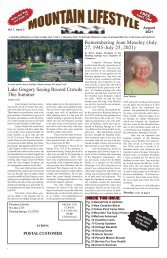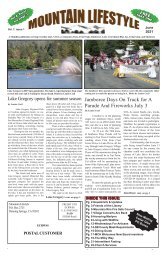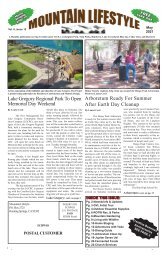You also want an ePaper? Increase the reach of your titles
YUMPU automatically turns print PDFs into web optimized ePapers that Google loves.
The larger of Saturn’s 53 moons are shown here. Saturn can be seen all<br />
night in the month of <strong>May</strong> <strong>2019</strong>. Photo courtesy of NASA.<br />
Observing Saturn—Jewel of the<br />
Solar System<br />
by Steven Peter<br />
If you happen to be outside<br />
in the mountain evening sky during<br />
the summer, Saturn is just above<br />
the horizon at sunset in the southeast<br />
and will be slightly higher in<br />
the sky each following night. Saturn<br />
is currently tipped 90 degrees and<br />
you can see the whole ring structure<br />
with just binoculars on a clear<br />
moonless night. It is located inside<br />
the constellation Scorpius. It’s best<br />
to see it later, after 10PM, as the sky<br />
stays lighter longer in the summer.<br />
Remember that if it isn’t twinkling,<br />
it’s probably a planet as planets reflect<br />
light from our sun and usually<br />
are void of emitting pulses of light<br />
(twinkling).<br />
Auto Repair Specialists<br />
Lowest Labor Costs Around<br />
ARE YOUR TIRES<br />
ready for winter?<br />
Next day delivery!<br />
FREE check<br />
engine light diagnosis<br />
(909) 324-1300<br />
(must present ad)<br />
good anytime<br />
coupon<br />
free rotor resurfacing<br />
with any regular brake job<br />
(Bring in this ad)<br />
offer expires 5-31-<strong>2019</strong><br />
Saturn is the second largest<br />
planet in our solar system, laced<br />
with thousands of beautiful ringlets,<br />
it is unique among the planets. It is<br />
not the only planet to have rings<br />
-- made of chunks of ice and rock<br />
-- but none are as spectacular or as<br />
complex as Saturn’s. Like its neighbor<br />
Jupiter, Saturn is a massive ball<br />
of mostly hydrogen and helium.<br />
Surrounding by 53 confirmed<br />
and nine proposed moons,<br />
Saturn is home to some of the most<br />
fascinating landscapes in our solar<br />
system. From the volcanic fountains<br />
of Enceladus to the methane lakes<br />
on hazy Titan, the Saturn system is<br />
a rich source of scientific discovery<br />
and still holds many mysteries.<br />
RS TIRES<br />
32022 Edison Way, Running Springs, CA<br />
we will match any tire price<br />
on the mountain!<br />
new &<br />
used<br />
tires<br />
Hours: Open 6 Days. 8am-5pm<br />
Open Saturdays • Closed Sunday<br />
The farthest planet from Earth observable<br />
by the unaided human eye,<br />
Saturn has been known since ancient<br />
times and is named for the Roman<br />
god of agriculture and wealth.<br />
The Greek equivalent was Cronos,<br />
the father of Zeus/Jupiter.<br />
It is enveloped by liquid<br />
metallic hydrogen, inside a layer<br />
of liquid hydrogen -- like Jupiter’s<br />
core but considerably smaller. It’s<br />
hard to imagine, but Saturn is the<br />
only planet in our solar system that<br />
is less dense than water. The giant<br />
gas planet could float in a bathtub<br />
-- if one could find on that large. As<br />
a gas giant, Saturn doesn’t have a<br />
true surface. The planet is mostly<br />
swirling gases and liquids. While a<br />
spacecraft would have nowhere to<br />
land on Saturn, it wouldn’t be able<br />
to fly through unscathed either. The<br />
extreme pressures and temperatures<br />
deep inside the planet would crush,<br />
melt and vaporize a metal spacecraft<br />
trying to fly through the planet.<br />
Saturn is blanketed with<br />
clouds, stripes and storms. Overall<br />
the planet is tan and light brown in<br />
color, due to a mixture of yellow<br />
ammonia crystals in the upper atmosphere.<br />
Winds in the upper atmosphere<br />
reach 1,600 feet per second<br />
in the equatorial region. In contrast,<br />
the strongest hurricane-force winds<br />
on Earth top out at about 360 feet<br />
per second. And the pressure -- the<br />
same kind you feel when you dive<br />
deep underwater -- is so powerful<br />
it squeezes gas into liquid. Even a<br />
metal spacecraft would be smashed<br />
in Saturn’s intense atmosphere.<br />
Saturn’s north pole has an interesting<br />
atmospheric feature -- a six-sided<br />
jet stream. There is no weather<br />
feature like it anywhere else in the<br />
solar system.<br />
Saturn’s environment is not<br />
conducive to life as we know it. The<br />
temperatures, pressures, radiation<br />
levels and materials that characterize<br />
this planet are most likely too<br />
extreme and volatile for organisms<br />
to adapt to.<br />
While planet Saturn is an<br />
unlikely place for living things to<br />
take hold, the same is not true of<br />
some of its many moons. Satellites<br />
like Enceladus and Titan, home to<br />
internal oceans, could possibly support<br />
life.<br />
Saturn is home to a vast array<br />
of intriguing and unique worlds.<br />
From the cloud-shrouded surface of<br />
Titan to crater-riddled Phoebe, each<br />
of Saturn’s moons tells another<br />
piece of the story surrounding the<br />
Saturn system.<br />
Saturn’s largest satellite, Titan,<br />
is a bit bigger than the planet<br />
Mercury.<br />
Saturn’s rings are believed<br />
to be pieces of comets, asteroids or<br />
shattered moons that broke up before<br />
they reached the planet, torn<br />
apart by Saturn’s powerful gravity.<br />
They are made of billions of small<br />
chunks of ice and rock. The ring<br />
particles mostly range from tiny,<br />
dust-sized icy grains to chunks as<br />
big as a house, though a few particles<br />
are as large as mountains. The<br />
rings would look mostly white if<br />
you looked at them from the cloud<br />
tops of Saturn. Saturn’s ring system<br />
extends up to 175,000 miles<br />
from the planet, yet the vertical<br />
height is typically about 30 feet<br />
in the main rings. Among the ring<br />
system are “braided” rings, ringlets<br />
and “spokes” -- dark features in the<br />
rings that form and initially circle<br />
the planet at different rates from<br />
that of the surrounding ring material.<br />
Saturn has seven separate rings.<br />
Saturn was the most distant<br />
of the five planets known to the ancients.<br />
In 1610, Italian astronomer<br />
Galileo Galilei was the first to gaze<br />
at Saturn through a telescope. To<br />
his surprise, he saw a pair of objects<br />
on either side of the planet. He<br />
sketched them as separate spheres,<br />
thinking that Saturn was triple-bodied.<br />
The oldest written records<br />
documenting Saturn are attributed<br />
to the Assyrians, described the<br />
ringed planet as a sparkle in the<br />
night and named it “Star of Ninib.”<br />
Around 400 BC Ancient Greek astronomers<br />
named what they thought<br />
was a wandering star in honor of<br />
Kronos, the god of agriculture. The<br />
Romans later change the name to<br />
Saturn, their god of agriculture. In<br />
July 1610, Galileo Galilei spotted<br />
Saturn’s rings through a telescope,<br />
but mistook them for a “triple planet.”<br />
In 1655 Christiaan Huygens<br />
discovered Saturn’s rings and its<br />
largest moon, Titan.<br />
More recently, the Saturn<br />
system has been visited by passing<br />
spacecraft, the Cassini orbiter and<br />
the Huygens probe. Pioneer 11 was<br />
the first spacecraft to reach Saturn<br />
on September 1, 1979. In its 1979<br />
flyby of Saturn, Voyager 1 revealed<br />
the intricate structure of the ring<br />
system, consisting of thousands of<br />
bands. Flying even close to Saturn<br />
in 1981, Voyager 2 provided more<br />
detailed images and documented<br />
the thinness of some of the rings.<br />
And on July 1, 2004 NASA’s Cassini<br />
spacecraft became the first to orbit<br />
Saturn, beginning a decade-long<br />
mission that revealed many secrets<br />
and surprises about Saturn and its<br />
system of rings and moons.<br />
Even the Europeans got in<br />
on the adventure with the European<br />
Space Agency’s Huygens probe<br />
being the first spacecraft to make<br />
a soft landing on the surface of another<br />
planet’s moon - Saturn’s giant<br />
moon Titan. The probe provided a<br />
detailed study Titan’s atmosphere<br />
during a 2 hour and 27-minute descent<br />
and relayed data and images<br />
from Titan’s muddy surface for another<br />
hour and 10 minutes.<br />
Nine Health Benefits Of Drinking<br />
Tea<br />
by Lynette Eastwood<br />
You may already know that<br />
tea can improve your skin and help<br />
keep you fit and trim, but many of<br />
us may not know that it also does<br />
amazing things for your health.<br />
Discover what being a tea connoisseur<br />
can do and improve your<br />
health life, after all it has been<br />
around for millennia. During that<br />
time, the Chinese have drunk it for<br />
everything from hangover prevention,<br />
to weight control and also for<br />
common cold relief. Now, our modern<br />
scientific research has given us<br />
a much better insight into how tea<br />
improves health and to what benefi<br />
t .<br />
True tea, or that from the<br />
Camellia synesis plant, includes<br />
white, green, oolong, black and Puerh.<br />
All of these teas contain antioxidants,<br />
catechins, and polyphenols,<br />
which have a positive impact<br />
our bodies.<br />
Research has shown that tea has:<br />
1. Lowered Cholesterol<br />
One popular and favorite healthy<br />
tea is green tea and it has been<br />
found to help lower cholesterol,<br />
both total serum cholesterol and<br />
LDL, according to a study in the<br />
American Journal of Clinical Nutrition.<br />
It is suggested that five cups<br />
per day will provide results, but<br />
multiple studies have shown that<br />
higher consumption leads to the<br />
biggest drop in cholesterol.<br />
Tea is believed to work by inhibiting<br />
the absorption of cholesterol<br />
from the large intestine. Among<br />
the Chinese, Pu-erh tea is the most<br />
known for its ability to lower cholesterol,<br />
although only minimal research<br />
has investigated this belief.<br />
2. Blindness Prevention<br />
Since tea contains high levels of<br />
antioxidants, it is not surprising<br />
that studies have found them in<br />
eye tissues. Drinking tea can help<br />
to prevent the blindness caused by<br />
cataracts (the clouding of the lens<br />
inside the eye).<br />
3. Reduced Cortisol Levels<br />
Cortisol is the stress hormone that<br />
contributes to belly fat and makes<br />
your skin age quicker. One recent<br />
study suggested four cups of tea per<br />
day may make your cortisol levels<br />
spike less.<br />
If you’re looking to have cortisol<br />
levels drop back down to normal<br />
faster after a stressful event, a study<br />
suggested daily consumption of tea<br />
for six weeks will do just that (as<br />
compared to placebo).<br />
The less cortisol your body produces<br />
the more slowing of the aging<br />
process and thus helping in the<br />
prevention of the widening of your<br />
mid-section.<br />
4. Anti-inflammatory<br />
Active compounds in tea can help<br />
to lower levels of inflammation and<br />
inflammatory reactions. According<br />
to specialists, inflammation is connected<br />
to almost every modern ailment,<br />
including arthritis, metabolic<br />
syndrome, and depression. Inflammation<br />
can also cause you to retain<br />
water and look puffy, so a few cups<br />
of tea can help you look and feel<br />
thinner.<br />
Other studies indicated the lower<br />
inflammation levels resulting from<br />
green tea consumption may help to<br />
protect against cardiovascular disease,<br />
just another added benefit of<br />
tea consumption.<br />
5. Increased memory - Focus &<br />
Concentration<br />
Extensive research has shown that<br />
the combinations of caffeine and<br />
L-Theanine (a naturally occurring<br />
amino acid found in tea) improves<br />
reaction time and memory, while at<br />
the same time increases focus and<br />
concentration (think of monks meditating<br />
as an ex<strong>amp</strong>le).<br />
It is suggested to have a cup of tea<br />
— perhaps white tea — before a<br />
meeting when you need to be sharp<br />
or drink it during a test for increased<br />
concentration and focus.<br />
6. Anti-allergen<br />
With spring here, now is time to<br />
start searching for your favorite tea.<br />
A Japanese study found that the tea<br />
polyphenol, EGCG, may be helpful<br />
for reducing pollen allergies. Tea<br />
Lynette Eastwood<br />
may also reduce allergic response<br />
through quercetin, a flavanol naturally-occurring<br />
in tea, which is<br />
known to alienate histamine response.<br />
By adding honey to your<br />
tea, you will double-up the anti-allergy<br />
power.<br />
7. Decreased Risk of Stroke<br />
Drinking at least three cups of<br />
green or black tea per day results<br />
in a 21% reduction in the risk of<br />
ischemic stroke, according to 2009<br />
study. Start your tea habit now,<br />
to begin protecting yourself earlier<br />
and improve your chances<br />
of living longer.<br />
8. Reduced Risk of Dementia<br />
To stay sharp, even as you age,<br />
drink tea, as it is thought to lower<br />
the risk of dementia by acting<br />
through multiple ways, including<br />
those of nerve synapses and<br />
blood sugar regulation. A study in<br />
Full Service Electrical Contractors<br />
Providing SOLUTIONS for All Your Electrical Needs!<br />
free estimates<br />
HOURS<br />
Mon-Fri<br />
8am-4pm<br />
Sat.<br />
8am-2pm<br />
Financing Available *<br />
with 18 months no interest option<br />
FACTORY AUTHORIZED<br />
• Sales • Service • Warrantee • Installation •<br />
THE CORNERSTONES OF OUR BUSINESS:<br />
•Quality-In Our Products<br />
•Value-In Our Pricing<br />
•Service-Exceeding Expectations<br />
•Integrity-In All business Dealings<br />
26914 Hwy. 189, Blue Jay, Agua Fria<br />
(909)<br />
744-8838<br />
panel special!<br />
FREE *<br />
With any Panel<br />
Change Out!<br />
FREE Surge Protector<br />
FREE County Permitting<br />
Valid until Apr. 30th, <strong>2019</strong><br />
2009 found that tea acts on brain<br />
theta waves to improve memory<br />
and increase attention span — this<br />
is another reason to start drinking<br />
tea early in life.<br />
9. Improved Overall Health<br />
Markers<br />
Tea drinkers tend to be healthier,<br />
which proves true, as tea drinking<br />
research also correlates with better<br />
health outcomes.<br />
You can help support your health,<br />
which includes your skin and body<br />
composition, with as few as 2-3<br />
cups per day of this calorie-free,<br />
sugar-free drink. This is a growing<br />
health movement and you can start<br />
today exploring the novelty of and<br />
many flavors of tea.<br />
There are countless types, blends,<br />
styles, countries of origins and<br />
more, all for you to try. There must<br />
be a tea to suit any taste and preference.<br />
So, go try, discover. Most of<br />
all, enjoy a cup of tea. Be a healthy<br />
tea connoisseur.<br />
Green Tea<br />
*O.A.C.<br />
•LIC. #913835<br />
• BONDED • INSURED •<br />
MOUNTAIN.ELECTRIC@YAHOO.COM<br />
Page 18 <strong>Mountain</strong> <strong>Lifestyle</strong> (C) <strong>May</strong> <strong>2019</strong> <strong>May</strong> <strong>2019</strong> <strong>Mountain</strong> <strong>Lifestyle</strong> (C) Page 19


















